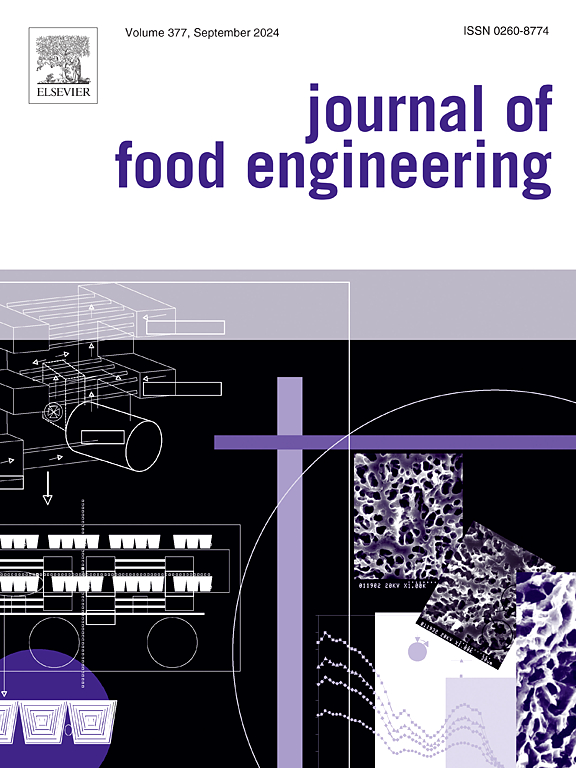Influence of temperature and shear rate during cooling on the rheological and textural properties of pea protein-based meat analogues
IF 5.3
2区 农林科学
Q1 ENGINEERING, CHEMICAL
引用次数: 0
Abstract
Pea protein isolate (PPI) is widely used to produce plant-based meat analogues via high-moisture extrusion. Key parameters during extrusion processing such as temperature and shear play critical roles in the structural changes that determine the final product's texture and mechanical properties. However, achieving a fibrous meat-like texture remains challenging. Consequently, this study aims to systematically investigate the effects of cooling die temperature and shear rate during the cooling phase of high-moisture extrusion on the rheological and textural properties of PPI-based meat analogues. A rotating cooling die system was employed to independently control shear rates (0–9.03 s−1) and cooling temperatures (70–90 °C). Texture and rheological analysis were conducted to assess hardness, anisotropy, and viscoelastic characteristics. The findings indicate that higher cooling die temperatures (up to 80 °C) resulted in harder extrudates with higher anisotropy, enhancing fibrous structure formation. Increased shear rates during cooling did not significantly influence the hardness and the anisotropy decreased. Hardness, anisotropy, and elastic modulus increased primarily due to enhanced aggregation via disulfide bonds, while aggregation through non-covalent bonds had a comparatively smaller impact on the mechanical properties. Thermomechanical treatment of PPI at higher moisture contents in a rheometer corroborated these results, with both shear rate and cooling temperature significantly affecting the elasticity. This indicated that predictive insights into the texturization potential of plant-based proteins can be gained under extrusion-like conditions by assessing their rheological properties.
冷却过程中温度和剪切速率对豌豆蛋白基肉类类似物流变学和质地特性的影响
豌豆分离蛋白(PPI)被广泛用于通过高水分挤压生产植物性肉类类似物。挤出过程中的关键参数,如温度和剪切,在决定最终产品的纹理和机械性能的结构变化中起着关键作用。然而,实现纤维状肉的纹理仍然具有挑战性。因此,本研究旨在系统地研究高水分挤压冷却阶段冷却模具温度和剪切速率对基于ppi的肉类类似物的流变学和质地特性的影响。采用旋转冷却模系统独立控制剪切速率(0-9.03 s−1)和冷却温度(70-90°C)。进行织构和流变分析以评估硬度、各向异性和粘弹性特性。研究结果表明,较高的冷却模具温度(高达80°C)导致更硬的挤出物具有更高的各向异性,增强了纤维结构的形成。冷却过程中剪切速率的增加对硬度的影响不显著,各向异性降低。硬度、各向异性和弹性模量的增加主要是由于二硫化物键的聚集增强,而非共价键的聚集对力学性能的影响相对较小。在流变仪中对PPI进行高含水率的热力学处理证实了这些结果,剪切速率和冷却温度都显著影响弹性。这表明,通过评估植物蛋白的流变特性,可以在类似挤出的条件下获得对植物蛋白纹理化潜力的预测性见解。
本文章由计算机程序翻译,如有差异,请以英文原文为准。
求助全文
约1分钟内获得全文
求助全文
来源期刊

Journal of Food Engineering
工程技术-工程:化工
CiteScore
11.80
自引率
5.50%
发文量
275
审稿时长
24 days
期刊介绍:
The journal publishes original research and review papers on any subject at the interface between food and engineering, particularly those of relevance to industry, including:
Engineering properties of foods, food physics and physical chemistry; processing, measurement, control, packaging, storage and distribution; engineering aspects of the design and production of novel foods and of food service and catering; design and operation of food processes, plant and equipment; economics of food engineering, including the economics of alternative processes.
Accounts of food engineering achievements are of particular value.
 求助内容:
求助内容: 应助结果提醒方式:
应助结果提醒方式:


